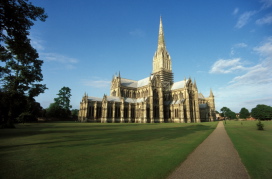
The fund has been boosted by property holdings including homes near London’s Hyde Park, and follows criticism about losses made in recent years through investment in the stockmarket.
The church’s balanced fund, which invests in stocks, bonds and property, posted an average annual return of 10 percent in the past decade, compared with 6.4 percent for 300 similarly managed funds, the Church of England said in a statement.
The apparent success of the fund will however raise questions about the way that the church is spending its money.
The amount available for charitable purposes totalled 106 million pounds last year, the lowest in at least 11 years.
The news of the success of the fund also follows a rejection by General Synod in February of plans to divert £5.5 million from Church of England cathedrals and bishops into mission work.
The idea was postponed indefinitely after a series of attacks by senior clergymen.
“These results show the long-term benefits of investing in a wide range of asset classes,” First Church Estates Commissioner Andreas Whittam Smith said in the statement. “The property holdings have been a big contributor to this result.”
The fund, which last year posted a return of 17 percent, is used to pay salaries and pensions of about 16,000 people working for the Church of England. It spent a record 100 million pounds on pensions last year and 50 million pounds on salaries and other costs for bishops, clergy and staff.
Over the past five years, the fund’s average annual return was 5.2 percent, compared with 1.6 percent for the 500 funds in the WM All Funds Universe. That also made it the best-performing fund over that period, according to WM, church commissioners’ spokesman Arun Kataria.
The church’s commercial property investments returned 7.7 percent in 2003 compared with 22 percent for farmland and 11 percent for residential property, the commissioners said.
Commercial properties include offices, factories and shops in England and Scotland. The offices are mainly in large cities, and the retail properties include warehouse parks and out-of-town shopping centres in partnership with developers.
At 1.14 billion pounds, the value of property assets was the highest in a decade, according to the fund’s balance sheet. Its real estate investments, which fell in value by 800 million pounds in the late 1980s, helped cut the loss on assets in 2002 to negative 9.3 percent. Similarly managed U.K. pension funds, which generally hold less property than the Church of England does, declined 18 percent in 2002.
Commissioners aim for an investment return of 5 percent or more after inflation to cover their spending plans, according to their web site. They say that they don’t invest in weapons or pornography, or any company whose main business is gambling, alcohol, tobacco or newspapers. However, investments have been made in some companies that produce weapons, on the basis that it is a small part of their overall business.
The Church Commissioners invest the wealth accrued since King Henry VIII broke with Roman Catholicism in the 16th century. The commissioners are some of the biggest landowners in England, with 125,000 acres, and invest almost 30 percent of the fund’s assets in property including shopping centres such as Bluewater in Kent.
The Church Commissioners who are accountable to the General Synod of the Church of England and to Parliament were formed in 1948 by joining together two bodies – Queen Anne’s Bounty and the Ecclesiastical Commissioners.
© 2004 Ekklesia. Posted on Religioscope with permission. An initiative of the Anvil Trust, Ekklesia is a not-for-profit think-tank which works to promote theological ideas in the public square. Website: www.ekklesia.co.uk